Last month we posted a feature on the "Newer Jerusalem suburbs. Talbieh. A Christian Arab community" along with a picture from the Library of Congress collection.
New Talbieh neighborhood
(circa 1925)
An enlargement of the one-story house in the picture on the right
The Talbieh neighborhood is adjacent to the Jewish neighborhood of Rehavia. After World War I, the land was sold by the Greek Patriarch to Arab Christians who built homes. British Mandate maps from the 1940s show approximately 90 homes, some residences for foreign consuls. In the 1930s several Jewish families also moved into the neighborhood.
After the 1947 UN Partition vote, Arab and Jewish tensions grew. Residents in the Arab and Jewish enclaves in each other's areas left, many expecting to eventually return. Such was the case with the Arabs of Talbieh.

The one-story house grew a second story by 1941 when the
building was converted to the Lady MacMichael British Red
Cross Convalescent house for British officers
We focused in our earlier feature on the one-story house and identified it as situated at the corner of what is today Jabotinsky and Yitzhak Elhanan Streets across from the Inbal Hotel.

Entrance to the MacMichael House

Aerial photo of Talbieh (circa 1935) The road going from
the bottom left to the top right is Jabotinsky Street today. Note
the two-story building on the corner
We recently found more pictures of the building in the Library of Congress files, pictures taken at the beginning of World War II when the building was converted into a convalescent house for British officers.
After the British left Palestine in 1948 and the 1949 armistice agreement, the State of Israel became the guardian of the building and made it available for private residence.
Click on pictures to enlarge. Click on caption to view the original photo.
The 5-story house today on the the corner of Jabotinsky Street,
once Emir Abdullah Street. (Credit: Google Maps, Street View)
A side view of the 5-story house
31
Another Historic Film: British General Allenby Entering Jerusalem -- From the Wonderful Archives of Ya'akov Gross
This film was posted last month by film collector Ya'akov Gross to commemorate the 95th anniversary of the capture of Jerusalem by the British Army. Gross has posted dozens of historic films on YouTube.
This film is, of course, a silent film with a musical score added. The captions are in Hebrew explaining as Allenby meets the commanders of the French and Italian armies, Jerusalem clergymen, and a short young officer named T. E. Lawrence (of Arabia).
Israel Daily Picture has posted on this website several other films from 100 years ago, including the first film made in the Holy Land in 1897.
Hat tip: NSP
Gen. Allenby enters Jerusalem's Old City andaddresses dignitaries and citizens of Jerusalem0
Add a comment
- The Library of Congress' photo collection of 22,000 pictures from the century-old American Colony photo department in the Holy Land is a credit to the Library, the curators, the restorers, and, of course, the members of the American Colony, themselves.
Our recent postings included evidence that these Christian utopians were "Zionists" well before Theodore Herzl, rejoicing in the return of Jews to Eretz Yisrael. The choice of photo subjects was remarkably "Jewish-friendly," a fact absent from other studies of the Colony's photos.
We also published newly-found pictures from a Scottish university's medical archives where we unexpectedly found photographs of the citizens of Tiberias.
We present this Table of Contents of more than 290 essays and hundreds of pictures to assist you in viewing this incredible historical treasure.
Click on the topic to see the original posting.
Biblical Sites
- Cave of the Patriarch, Hebron
- Joseph's Tomb, Shechem (Nablus)
- Kotel (Western Wall) - oldest picture?
- Kotel - First pictures publicized
- Kotel
- Beneath the Temple Mount
- Rachel's Tomb, Bethlehem
- Book of Ruth, photographic recreation
- Ezekiel's Tomb, Kifl Iraq
- King David's Tomb
- Agricultural prohibitions
- Masada
- Solomon's Pools 1, Solomon's Pools 2

Turkish guard at Joseph's Tomb, 1900
- Jewish Quarter
- Mt. of Olives
- 1949-1967 under Jordanian rule
- Expulsions of Jews, 1929, 1936, 1948
- Sabbath walk in the Old City

Snow at the Kotel (1921) - Light railroad line
- Snow 1
- Snow 2
- Jaffa Road
- Montefiore Windmill
- Meah She'arim 1
- Meah She'arim 2
- Everyday life
- Mt. Zion Hotel - St. John's Eye Hospital
- Funeral in Jerusalem
- Bukharan Quarter
- Nablus Road - where history marched
- The Citadel under Turkish rule
- The Citadel under British rule
- Mishkenot Sha'ananim
- King David Hotel bombing
- Bataei Machseh in the Old City
- Hebrew University
- Hebrew University foundation stone 1918
- Steamroller in Jerusalem Steamroller 2
- Jerusalem's Speed Limit
- Italian Hospital

Jaffa Gate, hand colored
- Gates of Jerusalem
- Color photographs of the gates
- Damascus Gate
- Dung Gate
- Golden Gate
- Herod's Gate
- Jaffa Gate
- Lions Gate
- New Gate
- Zion Gate 1
- Zion Gate 2
- Zion Gate 3

Samaritan priest
- Rosh Hashanna and the Shofar
- Yom Kippur at the Western Wall
- Sukkot
- Purim 1, Purim 2
- Tu B'Shvat tree-planting
- Tu B'Shvat trees of the Holy Land
- Passover, Yemenite Seder
- Lag B'Omer, Jerusalem 1
- Lag B'Omer, Jerusalem 2
- Lag B'Omer, Meron
- Tisha B'Av at the Western Wall
- Tisha B'Av
- Announcing the Sabbath
- Sabbath walk to the Western Wall
World War I
- Battle for Beersheva
- Battle for Gaza 1
- Battle for Gaza 2
- German general prevented massacre of Jews
- German commander who saved Jerusalem
- Turkish and German troops
- Prisoners of war
- Surrender of Jerusalem to British
- Cemetery for German pilots
- Battle for Tel a-Ful, Jerusalem
- Battle for Nebi Samuel
- Turkish naval base at the Dead Sea
- German weapons found at the Dead Sea
- Who is Colonel Coventry in Jerusalem?

Turkish troops at Nebi Samuel,1917
Anti-Jewish activity
- Hebron massacre 1929
- Tiberias massacre 1938
- Expulsion of Jews from Jerusalem
- British "White Paper" against Jewish immigration
- Women's Demonstration against the White Paper 1939
- Synagogues (destroyed) in Jerusalem 1
- Synagogues (destroyed) in Jerusalem 2
- Synagogues (destroyed) in Jerusalem 3
- Synagogues (destroyed) in Jerusalem 4
- Hassan Bey, the Hated Turkish Ruler

Aftermath of Hebron massacre
Economic activity
- Tel Aviv port
- Haifa port 1
- Haifa port 2
- Iraqi oil exports via Haifa
- Jewish industries 1
- Jewish industries 2
- Money-changing
- Graf-Zepellin over Jerusalem
- First aircraft
- Printing the first stamps
- Jerusalem Old City shopkeepers
- Immigration, Aliya
- Potash works at the Dead Sea

Building Haifa Port
Agricultural Activity
- Orange season

Harvesting grapes in Zichron Yaakov - Agriculture
- Locust plague of 1915
- Mikveh Yisrael Agricultural School (1898)
- Vineyards restored to the land
- Honey production for the New Year
- Carding Cotton
- Trees of the Holy Land
- Arab Revolt 1936 - 1939
- Precurser: Arab disturbances 1920, 1921
- The Arab revolt 1
- The Arab revolt 2
- The Arab revolt and the 1938 British annual report
- Attack on the railroads 1
- Attack on the railroads 2
- Attack on the railroads 3
- British response 1
- British response 2
- British Convoys
- British turn on the Jews of Palestine
- Palestine as "southern Syria"
- Arab market in Jewish neighborhood
- The Jews of Jerusalem
- Civil Defense
- British soldiers deploy to stop riots

Train detrailed in Arab revolt
Groups (by their origin, religion, ethnicity)
- Christian pilgrims
- Russian Christian pilgrims
- Yemenite Jews 1, and the American Colony
- Yemenite Jews 2, and the Turkish capitulations
- Yemenite Jews 3 celebrate Passover
- Yemenite Jews 4
- Bukhari wedding in Samarkand, 1870
- Bukhari community in Samarkand
- Ultra-Orthodox Jews, portrayed by actors 1
- Ultra-Orthodox Jews, actors 2
- Samaritans, Passover
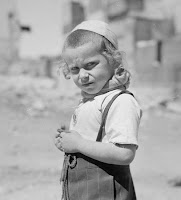
Jerusalem boy, 1930s - Samaritans, Tiberias
- Jewish women farmers 1
- Jewish women farmers 2
- Women at the Kotel
- Jewish Philharmonic
- Russian Proselytes from "Khudera"
- Children of the Old Yishuv
- Elderly Jews from the Old Yeshuv
- Elderly Jews of Jerusalem
- Old Jewish men in the Old City

Bukhari wedding, 1870
Ancient towns
- Safed (Tzfat)
- Beer Sheva
- Silwan village and a Yemenite Jew
- Tiberias 1, Tiberias 2
- Tiberias Jewry, Scot Hospital
- Jaffa and the mysterious railroad
Jewish Towns -- New
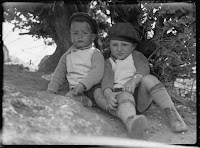
Children in Ben-Shemen (1920) - Zichron Yaakov
- Rishon LeZion
- Degania
- Tel Aviv
- Tel Aviv beach
- Kibbutz Ein Harod
- Kibbutz Geva
- Metullah
- Talpiot
- Hadera
- Gat
- Ein Gev -- "Tower and Stockade"
- Negba
- Ben Shemen
- Jezreel Valley
- Bnai Brak
- Mikve Yisrael
- Kfar Chassidim
- "Jewish colonies and settlements"
- Talbieh
- Kiryat Anavim
- Maaleh HaChamisha

1927 earthquake
Locations/Events
- Deir Yassin
- Homs and Hama in Syria
- Tribute to the people of Syria
- Damascus Revolt 1895
- Damascus Revolt 1925
- Ancient Aleppo
- Arab weddings in Judea and Samaria
- The first zoo in the Holy Land
- Earthquake!
- July 4 celebrations in Jerusalem
- Christmas in Bethlehem
- The Palace Hotel in Jerusalem
- Football in the Holy Land
- Tiberias flood
- Jews of Aleppo
- Jews of Alexandria
- Jews of Constantinople
- Jews of Damascus
- Jews of Kifl, Iraq (Ezekiel's Tomb)
- Jews of Tunis

Jews of Aleppo
- General Allenby
- General Allenby martial law
- Lord Alfred Balfour 1
- Lord Alfred Balfour 2
- Eliezer Ben-Yehuda
- Chaim Nachman Bialik, funeral
- Louis Brandeis, Nathan Straus, Stephen Weiss
- Winston Churchill 1
- Winston Churchill 2

Rabbi Kook in Washington DC 1924 - Rabbis
- Rabbi Kook
- Rabbi Kook meets President Coolidge in Washington 1
- Rabbi Kook meets President Coolidge in Washington 2
- Herbert Samuel, British High Commissioner 1
- Herbert Samuel, British High Commissioner 2
- Jacob Eliahu Spafford
- Yosef Trumpledor
- Mark Twain in the Holy Land
- William Seward
- Charles Warren
- Mendel Kremer, Turkish soldier and spy?
- Congressional visit, 1936

German Emperor in Palestine 1898 - Abraham Lincoln
- Jews welcome the German Emperor 1898
- The Pashas in Jerusalem 1916
- Pinchas Ruttenberg
- Jerusalem's Valero family
- Photographer Mendel Diness AKA Mendenhall John Dennis
- Photographer Elijah Meyers
- Elizabeth Dilling
- Dr. David Torrence
Film clips6
View comments
-

Entry of pilgims into Bethlehem at Christmas time (circa 1875) by photographer Félix Bonfils (Library of Congress)
The town of Bethlehem plays a major role in the Christian faith. There, Christians believe, Jesus was born some 2,000 years ago, and they celebrate his birth on Christmas.
Christmas procession in Bethlehem (circa 1900)
But when is Christmas?
Bethlehem hosts Christmas services for Roman Catholic and Protestant denominations on December 25. Coptic, Greek and Syrian Catholics will celebrate in the Church of the Nativity on January 6, and the Armenian Orthodox on January 19.
The photographs on this page were taken by the American Colony Photographic Department before and after World War I when the British captured Palestine after 400 years of Ottoman rule.

Church of the Nativity and Manger Square (circa 1898). Note
the unfenced cemetery on the left. View here the square and
cemetery approximately 20 years later, possibly under British rule
The name "Bethlehem" is derived from the Hebrew "Beit Lechem -- House of Bread," and its fields of grain are mentioned in the Book of Ruth as where Ruth gleaned her wheat for her mother-in-law Naomi and where she met her eventual husband, Boaz. According to the Bible, Ruth's great-grandson David was born in Bethlehem where he was anointed as king.
The Church of the Nativity was built in 339 CE by King Constantine and his mother, Helena, over the grotto believed to have been the site of Jesus' birth.
Throughout history the Church was destroyed and/or rebuilt by various conquering armies -- the Samaritans, Persians, Arabs, Crusaders, Mamluks, Ottomans and British.

The Grotto of the Nativity beneath the
Church (circa 1900)
In 1948, Bethlehem was conquered again, this time by the Jordanian Legion. Jordan ruled Bethlehem and the West Bank until 1967 when the territory was captured by Israel. In 1995, under the terms of the Oslo Accords, Israel transferred Bethlehem to the Palestinian Authority.
Bethlehem was traditionally a Christian town, built around the basilica, and tourism was the most important industry. In recent years, however, the proportion of Christians in Bethlehem has dropped from 85 percent in 1948 to 54 percent in 1967, and now to about 40 percent. Some analysts point to tensions between resurgent and aggressive Islamists and the Christian community, a phenomenon pressuring other Christian communities across the Middle East, with the exception of Israel.

British and French soldiers guarding the Church of the
Nativity (circa 1918)

Turkish soldiers drilling in the square outside of the Church of
the Nativity in Bethlehem (circa 1900)
Click on pictures to enlarge. Click on captions to view the original Library of Congress photo.
To subscribe, enter your email address in the box
in the right sidebar.0
Add a comment
Rabbi Mordechai Schornstein served as a rabbi in Copenhagen, Denmark, and moved to Palestine in 1935. On his way to the Holy Land he stopped in Italy and purchased birds and small mammals to start a pet store in Tel Aviv.
Tel Aviv zoo's crocodiles and turtles (circa 1939)

Griffon vulture
His collection grew, and in 1938 he opened a zoo in a residential area of Tel Aviv. With the arrivals of lions, tigers and elephants the zoo was forced to moved and re-housed at a location not far from Tel Aviv's City Hall.
Urban growth, however, meant that Tel Avivians did not want a zoo in their midst. Public awareness of animal care and zoo overcrowding forced another move in 1980, this time to a large Ramat Gan park nearby. The 250-acre "Ramat Gan Safari" now contains some 1,600 animals.
Hyena played with zookeeper

Lion in the Tel Aviv zoo
The Library of Congress-American Colony Photographic Department captions lists the pictures as taken between 1936 and 1939. The zoo's timeline, however, suggests that 1939 was a more likely date.

Monkey, held by a keeper

"Ibex, the wild goat of the Bible"
0
Add a comment
- Are you a subscriber?Don't miss a single edition. Don't let history pass you by.
Register your email in the box in the right column.0
Add a comment
20
The Caption Read "Jewish Colonies and Settlements" -- And That's How the "Israel Daily Picture" Got Started
The Congressional Research Service is a top-notch research organization providing policy analyses to Members of Congress and congressional committees. It is housed in the Library of Congress, and many of their reports are available to the public.

"Jewish colonies. Balfouria orange groves" and a synagogue
in the middle (1934). Named in honor of the British author of the
Balfour Declaration
Eighteen months ago, Lenny Ben-David, a policy and public affairs consultant and former Israeli diplomat in Washington, searched online for a report on U.S. policy on Israeli settlements. Up popped on his screen a title, "Jewish Colonies and Settlements," a very curious title. Colonies?

Colony of Rishon LeZion (c 1920)

Threshing with a board at "Jewish
Colonies and Settlements" (c 1920)
As Ben-David delved into the Library's files he came across the recently digitalized American Colony-Matson collection of some 22,000 photographs, dating from the 1890s until 1946. Some were captioned, "Jewish Colonies and Settlements." After the American Colony Photographic Department closed in the 1940s, the pictures and negatives were shipped back to the United States. In the 1970s an old age home in California donated them to the Library of Congress. The Library of Congress collection also included other pictures by pioneer photographers dating back to the 1850s.
Upon viewing the vast collection and understanding its historical significance, Ben-David launched the www.israeldailypicture.com site.

"Jewish colonies. Commencing a
Jewish settlement. Men and
women working" (1920)Israel Daily Picture has featured essays on the founders of the American Colony who arrived in Palestine in 1881 and saw the return of Jews to the Land of Israel as fulfillment of a Biblical prophecy. Hundreds of pictures depict Jewish life in the Holy Land in the 19th and early 20th centuries, decades before Israel's founding in 1948.
Click on pictures to enlarge. Click on caption to view the original picture.
Already in 1898, a photographer from the American Colony, reportedly hired by Zionist leader Theodor Herzl, traveled throughout Palestine photographing Jewish settlements for an album presented at the 1899 Zionist Congress in Basel.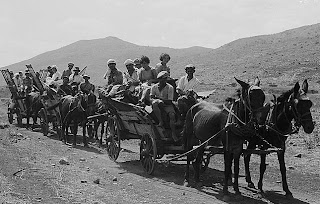
"Commencing a settlement. Jewish
settlers arriving" (1920)
We present here a collection of photos taken at the newYishuv's communities.

"Colonies:" Tel-Hai Farm

Mishmar HaYarden

Yesod HaMa'aleh (many of
its farmers were "Subbotnik"
Russians who converted to
Judaism.) See here

Migdol

Degania

Children picking almonds
at Rishon LeTzion0
Add a comment
Horatio and Anne Spafford, the American Colony founders, arrived in Jerusalem in 1881. Millennialists and Utopian Christians, they established a commune-like way of life with followers from the United States and Sweden who worked on a farm, dairy, carpentry shop, and bakery. The American Colony was well-known for its philanthropic works in Jerusalem among civilians of all faiths, especially during the severe hardships of World War I in Palestine.
Anne and Horatio Spafford,
founders of the American Colony
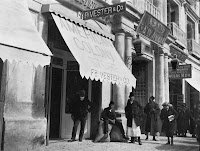
American Colony store inside the
Jaffa Gate (circa 1905)
The American Colony also established a store inside the Jaffa Gate in the Old City to cater to tourists and pilgrims to the Holy Land. Their photographs and post cards were in high-demand among the visitors.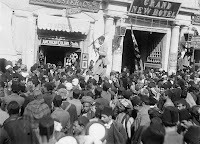
Man dancing with swords outside of
the American Colony store, displaying
its photos and postcards (circa 1914)
The American Colony Photographic Department was established in 1898 by a Colony member, Elijah Meyers, a Bombay Jew who converted to Christianity. He trained young photographers at the American Colony, some of whom continued working in the Department until 1946.
Elijah Meyers
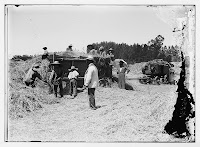
Jews harvesting (circa 1898)
It is believed that Meyers was photographing in Jerusalem prior to 1898 as well. His photographs of 1898 visit of the German emperor to Jerusalem were sold by the American Colony around the world.
Students in Mikveh Yisrael school The Library of Congress narrative that accompanies the American Colony collection reports that in 1898, the “American Colony Photo Department photographers headed by Elijah Meyers were hired by Zionist [leader] Theodor Herzl to document Jewish settlements.”Meyers accompanied his friend and fellow photographer Yesha'yahu Raffalovich on a tour of the Galilee to prepare photographs for the 1899 Zionist Congress in Basel. These pictures from the Library of Congress - American Colony collection are not dated or captioned, but it is likely they are from the Meyers-Raffalovich expedition.0
Add a comment
This picture from the Library of Congress -- American Colony Photographic Department collection was taken from the newly constructed YMCA tower in Jerusalem in 1933. The photographer was looking east toward the Old City and the Mount of Olives beyond.
Looking east from the YMCA tower in Jerusalem in 1933. What is in the picture?
The photo also shows four domes in close proximity to the Temple Mount -- the Dome of the Rock and then three domes in a row to the right, the Hurva Synagogue, followed by the Tiferet Yisrael Synagogue, and then the Al Aqsa Mosque.
Prominent in the foreground is the King David Hotel. In the background are the Mount of Olives and Mount Scopus.
The two large synagogues were blown up in 1948 after the Old City and Jewish Quarter fell to the Jordanian Legion.
Enlargement of the three domes: Hurva, Tiferet
Yisrael and al Aqsa

The two synagogues with the Hurva on the right
(Library of Congress collection, 1900)
The two synagogues were prominently featured in the other pictures taken around 1900.

The two synagogues, with Tiferet Yisrael on
the left.
In 1949, the city of Jerusalem was riven by an armistice lines with barbed wires, walls, and border crossings. It remained split until 1967 when the city was reunited in the "Six-Day War."
Click on the photos to enlarge.
Click on the captions to see the originals.
The same view today
The Hurva was rebuilt in 2010. Plans to rebuild the Tiferet Yisrael Synagogue were announced by the Jerusalem Municipality in November 2012.Google Earth view today of the area in the 1933 American Colony picture
Subscribe online by visitingwww.israeldailypicture.com and enter your email in the box in the right sidebar.0
Add a comment
- The answer next week in www.israeldailypicture.com and in The Jerusalem Post Magazine.
Does anyone know who the Rabbis are?

Picture taken in 1859 or 1860. This picture was part of a collection found in a garage sale 20 years ago.
Who was the photographer?
Enlargement. Who are the rabbis? 2
View comments
Some Jerusalemites will recognize the houses and street in this American Colony photo taken about 1930. The caption reads, "Newer Jerusalem suburbs, Talbieh, a Christian Arab community." The street back then was called Emir Abdullah Road.
A view of Talbieh (circa 1930, Credit: Library of Congress)
The neighborhood is adjacent to the Jewish neighborhood of Rehavia. After World War I, the land was sold by the Greek Patriarch to Arab Christians who built homes. British Mandate maps from the 1940s show approximately 90 homes, some residences for foreign consuls. In the 1930s several Jewish families also moved into the neighborhood.
After the 1947 UN Partition vote, Arab and Jewish tensions grew. Residents in the Arab and Jewish enclaves in each other's areas left, many expecting to eventually return. When the British departed Palestine in May 1948, even some of the Talbieh Arabs who wanted to stay were under pressure and threats by both Arab and Jewish militias to leave. One wealthy Arab Christian "received threats from people in the Old City that his family would be murdered because he had decided to stay in Talbieh, because his presence there showed that it was possible to live together with the Jews," one Jewish old-time Jerusalemite related.
[The Arab Christian businessman rented his home to the Belgian consul. The diplomat's secretary, who was also a friend of the businessman, helped arrange the rental and kept inventory of the Arab's possessions left in the house, according to a Ha'aretz account. When it was apparent that the man would not be returning, she rolled up his rugs, packed his belongings and silver and shipped it to the him in Beirut via Belgian observers from the UN. The secretary, Esther Milikovsky, was Benjamin Netanyahu's aunt.]Jabotinsky Street today, once Emir Abdullah Street. (Credit:
Google Maps, Street View) The first house on the left had three
stories added. Note the double porch on the second building.

Note the double porch in the circle
Jews who were expelled from their neighborhoods during the fighting were often resettled in the former Arab neighborhoods of Jerusalem.
So where is this block of houses in Talbieh? Emir Abdullah Street is now called Jabotinsky Street. The first house in the 80-year-old picture is across the street from the Inbal Hotel. The one story structure had an additional three floors added to it. If there are any doubts about the location of the buildings and street, note the double porch on the adjacent building.
Click on the picture to enlarge.
Click on the caption to view the original.0
Add a comment
3
150 Years Ago in Jerusalem -- This Is the Place for Photographs. But It's Also the Place to Read What the Tourists & Explorers Wrote

Mark Twain, 1867 
William Seward, Lincoln's
Secretary of State
Befitting its name, the Israel Daily Picture site focuses on century-old photographs from Eretz Yisrael, but the confluence of three visitors to the Holy Land almost simultaneously 150 years ago brings us today to focus on their words, not just the photographs of their time.
Charles Wilson, British officer
Another confluence, this one of the technology of the steamship and photography, helped spur tourism to Palestine, suggests Kathleen Stewart Howe, an American curator and historian of photography. The author of Revealing the Holy Land, the Photographic Exploration of Palestine, Stewart Howe explained in a recent lecture, "Photography and travel to the Holy Land were an interlocking system... Photography encouraged tourism and travel; tourism consumed photography." Eighteen thousand tourists visited the Holy Land on organized tours between 1868 and 1880, she reported.
Are these tourists Twain's colleagues?
The American author and humorist Mark Twain visited the Holy Land in 1867 as part of a tour group consisting of "64 pilgrims and sinners." He filed dispatches to newspapers in the United States and then republished them as Innocents Abroad. [We continue to investigate whether pictures we found in the Library of Congress collection may be Twain's traveling partners posing in front of the Old City's Golden Gate.] View an earlier posting on Twain's visit here.
According to historians, Twain and his party stayed at the Mediterranean Hotel in Jerusalem's Old City at the same time as the British expedition led by Charles Warren, a co-author with Charles Wilson of The Recovery of Jerusalem, a Narrative of Exploration and Discovery in the City and the Holy Land. Wilson's 1865 Ordnance Survey included many photographs by Sgt. James McDonald. Could the photos of the Jerusalem "tourists" have been taken by Warren's photographer, Corporal Henry Phillips two years later?
Warren, seated on the left, and his team.
Phillips is seated on the right (1867)
The third writer, William Seward, visited Palestine in 1859 and again in 1871. Seward served as President Abraham Lincoln's Secretary of State and was wounded in his home by one of John Wilkes Booth's accomplices on the same night that Lincoln was shot. Mary Todd Lincoln told the Springfield, Ill. pastor who presided at her husband's funeral, "He [Lincoln] said he wanted to visit the Holy Land and see those places hallowed by the footprints of the Saviour. He was saying there was no city he so much desired to see as Jerusalem."
We surmise that Lincoln had heard about Jerusalem and the Holy Land from his Secretary of State.
Here are excerpts of their writings:
- On the population of Jerusalem
- Twain: The population of Jerusalem is composed of Moslems, Jews, Greeks, Latins, Armenians, Syrians, Copts, Abyssinians, Greek Catholics, and a handful of Protestants.... It seems to me that all the races and colors and tongues of the earth must be represented among the fourteen thousand souls.
Ashkenazi Jews. Photo probably
taken by Warren's photographer,
1867
Armenian priests. Photo probably
taken by Warren's photographer, 1867
- Wilson: It is difficult to obtain statistical information on Jerusalem, but one fact alone will show the unhealthy nature of the city: The Jewish population is estimated at about 9,000, yet in twelve months, more than 13,000 cases of sickness were attended to in their own hospital and that of the Protestant Mission.
- Seward: The population of Palestine is estimated at only 200,000.... Jerusalem is divided now according to its different classes of population. The Mohammedans are four thousand, and occupy the northeast quarter, including the whole area of the Mosque of Omar. The Jews are eight thousand; and have the southeast quarter.... The Armenians number eighteen hundred, and have the southwest quarter and the other Christians, amounting to twenty-two hundred, have the northwest quarter.
- On the status of the Jews
- Wilson: I offered to take Jews upon the [excavation] works; but though some came to try it, one day was always quite sufficient for them, they were quite unused to the hard work. I had, however a Jewish overseer, that it a man who kept above ground, and beat the men with his corbatch [or kurbash, leather strap] when they were idling. He was a first-rate fellow, and was called by the fellahin "the devil" -- the only Jew I met in the country was was not afraid of the natives.
- Seward: For centuries (we do not know how many) the Turkish rulers have allowed the oppressed and exiled Jews the privilege of gathering at the foot of this [wailing] wall one day in every week, and pouring out their lamentations over the fall of their beloved city, and praying for its restoration to the Lord... The Jewish sabbath being on Saturday, and beginning on Friday, the weekly wail of the Jews under the wall takes place on Friday.
Twain: At that portion of the ancient wall of Solomon's Temple which is called the Jew's Place of Wailing, and where the Hebrews assemble every Friday to kiss the venerated stones and weep over the fallen greatness of Zion, any one can see a part of the unquestioned and undisputed Temple of Solomon, the same consisting of three or four stones lying one upon the other.
Women at the Western Wall; Men are
at the far right- Now booking lectures in Israel in December“The Hidden Message withinAntique Pictures of the Holy Land”By Israel Daily Picture's publisher, Lenny Ben-David2
View comments
30
A Collection of 150-Year-Old Pictures of Jerusalem Thanks to British Explorers and the New York Public Library
The photographic archives in the New York Public Library is the surprising repository for hundreds of historic photographs of Palestine. Some of the pictures date back to the 1850s and 1860s.
Cover of the Ordnance Survey
(1865)
We provide here a selection of some of the amazing photographs. Future postings will focus on particular pictures and the photographers.

Survey photo of the "Wailing Place of the Jews"
(1865). The photo was taken by Peter Bergheim who
established a photographic studio in the Christian
Quarter of the Old City. The Survey team had its
own photographer, but, apparently, Bergheim was
subcontracted by the Survey team. (Source: New
York Public Library) See here for similar photos.
Many of the photos were taken from the British Ordnance Survey of Jerusalem of 1865 led by Captain Charles W. Wilson. He and Captain Charles Warren led extensive archaeological excavations near the Temple Mount ("Wilson's Arch" and "Warren's Shaft" are well-known to visitors to Jerusalem). Warren would go on to become the head of London's police during the "Jack the Ripper" murder spree.
We thank staffers at the Library of Congress who steered us to the Survey and officials at the New York Public Library who granted permission to publish the photos.
The sealed Golden Gate, also known as Shaar
Harachamim (1865), is located on the eastern wall
of the Old City and closest to the site of the Jewish
Temple and the Dome of the Rock. The photo was
taken by the Survey's official photographer, James
McDonald. (Source: New York Public Library)
See here for similar photos.
The 1865 Survey contained measurements, maps and descriptions of the city of Jerusalem which was almost all contained within the Old City walls. The explorers sank shafts along the Old City walls, explored underground tunnels, cisterns and caverns, and recorded their findings.
In 1871,Wilson and Warren published The Recovery of Jerusalem, a Narrative of Exploration and Discovery in the City and the Holy Land, a memoir of their experiences in Jerusalem, including dealing with rapacious Ottoman officials, impassible roads, and local workers.
Interestingly, the Wilson-Warren book did not include photographs; it was illustrated with woodcuts such as this one possibly copied from the Bergheim photo above. And note how similar the woodcut is to the one illustrating William Seward's travelogue. Seward was Abraham Lincoln's Secretary of State who visited the Holy Land in 1859 and 1871. Both books, published in 1871, describe Jewish prayer at the Western Wall as restricted to Friday evening.
Woodcut in Seward's book

The woodcut in Wilson's book 1
View comments
The Library of Congress archives of 19th and early 20th century photographs from the Holy Land still has more veins of treasures to be mined byIsrael Daily Picture.
"Shepherd and sheep." Where? South on Nablus Road in Jerusalem (circa 1900)
The mosque and minaret are still there today. Credit: New York Public Library
But we would like to add two more American Colony pictures which we found in the New York Public Library archives to our previous postings. We thank the NYPL for granting permission to present them here.

Turkish soldiers marching on Nablus
Road past the same minaret
(circa 1900)
The first is a picture of shepherds and sheep. What drew our attention were the buildings and mosque, easily identified in our feature "Jerusalem's Nablus Road -- Where History Marched." The original caption to the photograph of the soldiers notes that they were passing the American Colony residence, located on Nablus Road.
The Colony's location gave the photographers a front row seat for the arrival of the German Emperor Wilhelm II in 1898.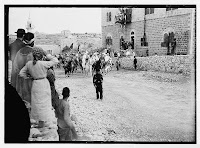
Emperor Wilhelm passing the Colony's
residence. Note the minaret above the
ultra-Orthodox Jew's hat on the left.
(1898)
The second photo found in the New York Public Library is a picture of farming practices in Palestine over 100 years ago. The American Colony photographers frequently shot pictures of mismatched plowing animals.

Peasant plowing (circa 1900)
Credit: New York Public Library
We theorize that the American Colony members, who were well versed in the Old Testament, focused on agricultural prohibitions found in the Bible.
In this particular case, they illustrated the prohibition "Thou shall not plow with an ox and an ass together." (Deuteronomy 20)
They also provided pictures of the prohibition "Thou shall notmuzzle an ox in its threshing"
(Deuteronomy 25)
Click on the photos to enlarge. Click on the captions to see the originals.
Subscribe by entering your email address in the box in the right sidebar of the Online version -- it's free!
Click on the photos to enlarge.
Click on the captions to see the originals.
2




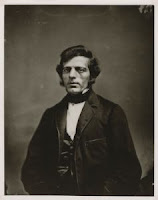
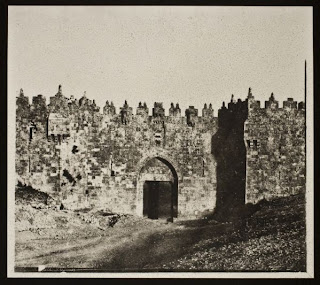





View comments